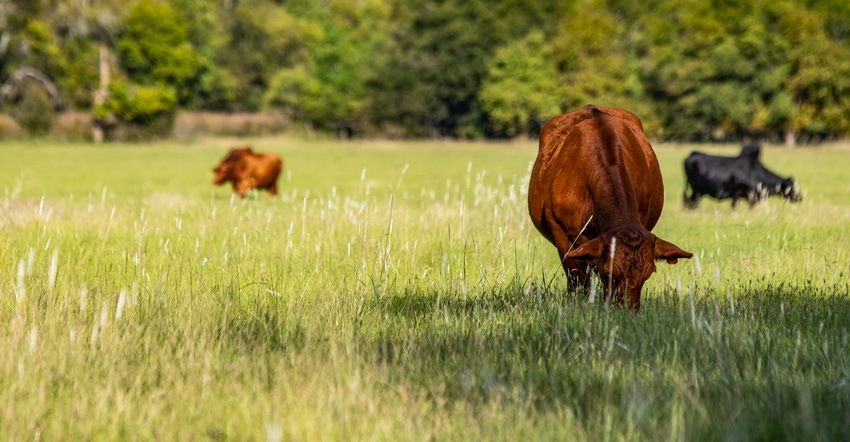June 26, 2019

Seldom do we talk about forage shortages and above-normal precipitation in the same breath. Regardless, that’s where we are now throughout Ohio and much of the Midwest. Over the past year, abundant rainfall has allowed us to grow lots of forage. Unfortunately, it seems the weather has seldom allowed us to harvest it as high-quality feed.
Since last fall, the demand for high-quality forages has been on the increase. It began with a wet fall that forced us from pasture fields early. With constantly muddy conditions, cattle were requiring more feed and energy than normal. At the same time, even though temperatures were moderate during much of the fall of 2018, cows with a constantly wet hair coat were, yet again, expending more energy than normal to remain in their comfort zone. Then, as a cold late January evolved into February this year, in many cases, mud had matted down the winter coats of cattle — reducing their hair’s insulating properties. This caused them to require even more energy in the cold weather.
Reduced supplies of high-quality forages coupled with increased demand over the past year have led us to a perfect storm that’s resulted in the lowest inventory of hay in Ohio since the 2012 drought, and the fourth-lowest in 70 years. Spring 2019 weather didn’t provide the opportunity to improve that situation. Today, cattle producers throughout the Midwest are nearly having a forage and feed crisis.
Over the years, it seems that any time I’ve had conversation about a forage shortage — unlike now, most often the result of drought conditions — friend and former colleague Ed Vollborn would respond simply by saying, “If you can’t increase the feed, reduce the need.” Today, many Ohio cattle producers are facing those crossroads ... by fall, we need to either find some creative ways to increase the feed supply, or we must reduce the need to levels that match our inventory of feed.
Let’s spend a few minutes exploring both. First, a look at opportunities for increasing the feed.
Increase feed
Up to 50 units of nitrogen applied to late-summer cuttings of grass hay or pasture has the potential to add up to a ton of additional forage. Fertilized late cuttings of grass hay also have the potential for higher protein content.
If vacant fields remain available as a result of harvested wheat — or perhaps failed spring corn or soybean plantings — annual forages such as oats can still be planted. Oats planted in July or early August can yield from 2 to 5 tons of dry matter; yet, this calendar year that could then be harvested as either feed or bedding.
With the recent announcement by USDA’s Risk Management Agency to move the earliest date for haying and grazing of forages from Nov. 1 to Sept. 1, and to also allow chopping for silage, haylage, and baleage under RMA’s prevented planting provisions, an opportunity exists to harvest the oats and follow them with yet another forage planting, which could then be harvested in spring 2020.
If that need for additional forage is expected to continue into next spring, either biennials such as Italian ryegrass or cereal rye — or perhaps a permanent seeding — can be planted into any fields that are still vacant in August, or that perhaps become available after Sept. 1. Italian ryegrass or cereal rye will grow modestly yet this fall and could be grazed. Abundant growth, however, will happen in the spring, which could be harvested as high-quality hay or silage in mid-May, before the field is planted into another crop such as corn or soybeans. If the permanent seeding is preferred, August provides that opportunity on available fields.
Reduce need
If we fail in efforts to increase the feed sufficiently, the solution turns to reducing the need. We do have a few alternatives available for consideration yet this summer.
Perhaps the most obvious opportunity here is to pregnancy-check the females in the herd and cull any that are open. Pregnancy checking and culling early not only saves feed, but also allows open cows to be sold into a stronger cull market — before cows culled at a more traditional time, late summer, flood the market.
Early weaning of the 2019 calf crop also will reduce whole-herd feed requirements. Lactating cows require as much as two-thirds more feed than dry, gestating cows. At the same time, weaned calves will more efficiently use feed than their nonweaned contemporaries, oftentimes converting feed to gain at a rate of 3 to 5 pounds of feed for 1 pound of gain. An additional benefit to early weaning that is particularly beneficial for retained-ownership calves is the acceleration of the growth curve and increased marbling potential in the calf.
The reality is, the inventory of high-quality forages across Ohio and the Midwest is very short — and we’ll all agree, it’s impossible to starve a profit into a cow. Today we still have options: We can either find some creative ways to increase the feed, or we must reduce the need!
Smith is a program assistant in the Ohio State University Fairfield County Extension office and a member of the OSU Extension Beef Team. The Beef Team publishes the weekly Ohio BEEF Cattle letter, which can be received via email or found at beef.osu.edu.
About the Author(s)
You May Also Like




